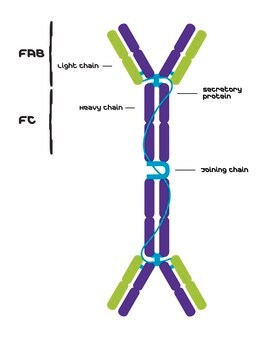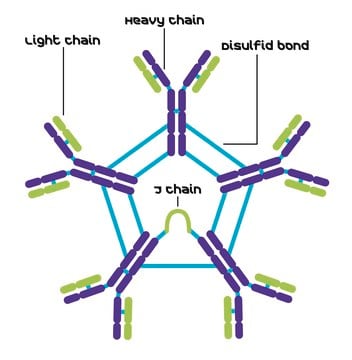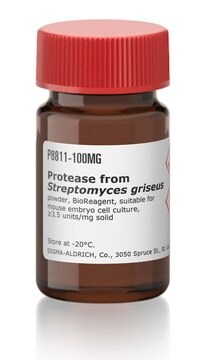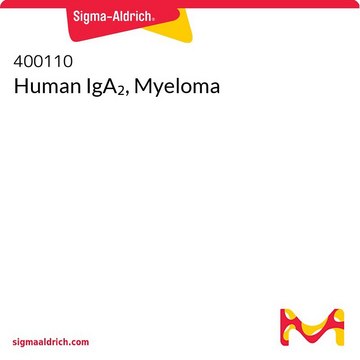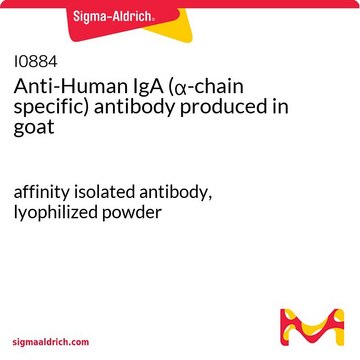M1421
IgA, Kappa from murine myeloma
clone TEPC 15, purified immunoglobulin, buffered aqueous solution
Synonym(s):
Mouse IgA-κ
Sign Into View Organizational & Contract Pricing
All Photos(1)
About This Item
Recommended Products
biological source
mouse
conjugate
unconjugated
antibody form
purified immunoglobulin
clone
TEPC 15, monoclonal
Assay
≥90% (non-reduced, SDS-PAGE)
form
buffered aqueous solution
shipped in
dry ice
storage temp.
−20°C
target post-translational modification
unmodified
Looking for similar products? Visit Product Comparison Guide
General description
IgA antibody is secretory antibody and is present abundantly in mucous linings of gastrointestinal, respiratory and genitourinary tracts, tears and saliva. Thus secretory IgA contributes to the humoral defense mechanism against the pathogens on mucosal surfaces
IgA, κ from murine myeloma is produced by TEPC 15 tumor line that is pristane-induced plasmacytoma originated and carried intraperitoneally in BALB/c mice. The antibody is specific for κ chain of mouse IgA. The purified immunoglobulin preparation is non-reactive with anti-mouse IgM, IgG1, IgG2a, IgG2b, and IgG3.
IgA, κ from murine myeloma is produced by TEPC 15 tumor line that is pristane-induced plasmacytoma originated and carried intraperitoneally in BALB/c mice. The antibody is specific for κ chain of mouse IgA. The purified immunoglobulin preparation is non-reactive with anti-mouse IgM, IgG1, IgG2a, IgG2b, and IgG3.
The TEPC 15 tumor line that produces mouse IgA,k is pristane-induced plasmacytoma originated and carried intraperitoneally in BALB/c mice. Immunoglobulin G (IgG) belongs to the immunoglobulin family and is a widely expressed serum antibody. An immunoglobulin has two heavy chains and two light chains connected by a disulfide bond. It mainly helps in immune defense. It is a glycoprotein. IgG is a major class of immunoglobulin. Mouse consists of five immunoglobulin classes- IgM, IgG, IgA, IgD and IgE. IgA molecules in the serum are mostly dimeric. IgA is found in saliva, tracheobronchial secretions, genitourinary secretions, milk and colostrum.
Specificity
Antigen Specificity: phosphoryl choline
Application
Anti-Mouse IgA, κ antibody was used as secondary antibody in ELISA and immunoflourescence.
IgA, Kappa from murine myeloma has been used in:
- immunofluorescence assay
- enzyme-linked immunosorbent assay (ELISA)
- invasion assays
- western blotting
Biochem/physiol Actions
Immunoglobulin G (IgG) helps in opsonization, complement fixation and antibody dependent cell mediated cytotoxicity.
Physical form
Solution in 0.02 M Tris buffered saline, pH 8.0, containing 0.02% sodium azide
Disclaimer
Unless otherwise stated in our catalog or other company documentation accompanying the product(s), our products are intended for research use only and are not to be used for any other purpose, which includes but is not limited to, unauthorized commercial uses, in vitro diagnostic uses, ex vivo or in vivo therapeutic uses or any type of consumption or application to humans or animals.
Storage Class Code
10 - Combustible liquids
WGK
WGK 3
Flash Point(F)
Not applicable
Flash Point(C)
Not applicable
Personal Protective Equipment
dust mask type N95 (US), Eyeshields, Gloves
Choose from one of the most recent versions:
Already Own This Product?
Find documentation for the products that you have recently purchased in the Document Library.
Customers Also Viewed
AdcAII of Streptococcus pneumoniae affects pneumococcal invasiveness
Brown LR, et al.
PLoS ONE, 11(1), e0146785-e0146785 (2016)
Julio Villena et al.
The Journal of nutrition, 135(6), 1462-1469 (2005-06-03)
We studied the effect of Lactobacillus casei CRL 431 used as a supplement in a repletion diet on the resistance to Streptococcus pneumoniae respiratory infection in malnourished mice. Weaned mice were malnourished after they consumed a protein-free diet (PFD) for
Lindsey R Brown et al.
Frontiers in cellular and infection microbiology, 7, 233-233 (2017-06-24)
Bacteria growing within biofilms are protected from antibiotics and the immune system. Within these structures, horizontal transfer of genes encoding virulence factors, and promoting antibiotic resistance occurs, making biofilms an extremely important aspect of pneumococcal colonization and persistence. Identifying environmental
The Laboratory Rat (1998)
Carlos J Sanchez et al.
PloS one, 6(12), e28738-e28738 (2011-12-17)
It is unclear whether Streptococcus pneumoniae in biofilms are virulent and contribute to development of invasive pneumococcal disease (IPD). Using electron microscopy we confirmed the development of mature pneumococcal biofilms in a continuous-flow-through line model and determined that biofilm formation
Our team of scientists has experience in all areas of research including Life Science, Material Science, Chemical Synthesis, Chromatography, Analytical and many others.
Contact Technical Service